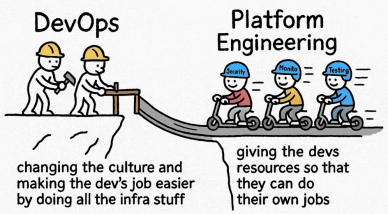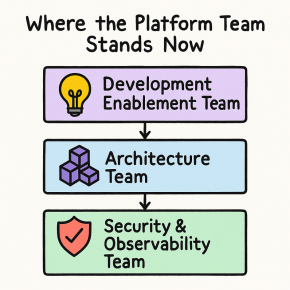At YouLend, we build the infrastructure that powers flexible financing for businesses across the world. We work with technology companies, payment platforms, marketplaces, and e-commerce providers to help them offer seamless funding to the small and medium-sized businesses they serve.
But what does that look like from a technology perspective?
In the early days, our engineering team was built around DevOps: a bridge between developers and operations, designed to help us ship software safely and fast. But as we scaled and matured, that model grew and needed an upgrade.
This is the story of how YouLend evolved from fragmented DevOps to a unified Platform Engineering organisation – and what it took to build a more unified, efficient, and scalable foundation for everything we build today.
The Rise and Limits of DevOps
DevOps emerged to solve a real problem: developers wanted to move fast, but struggled with the operational overhead of deploying and maintaining code. By bringing together development and operations, DevOps enabled teams to deliver code faster and with greater reliability.
But as the approach matured, so did the complexity. DevOps teams became responsible for tooling, automation, cloud infrastructure, monitoring, and security all at once. What started as a single function ballooned into new specialisations – SysOps, DevSecOps, FinOps – and “DevOps” became an umbrella term.
This is exactly what happened at YouLend. As the platform grew, we split responsibilities across new functions:
- SysOps, focused on maintaining infrastructure and reacting to issues
- DevSecOps, embedding security into our processes
- Platform Excellence, ensuring speed and stability across systems
The Platform Excellence team was YouLend’s first real test of what would later become Platform Engineering. It brought the right mindset – enabling developers rather than simply supporting them – and its success proved there was a better way to structure engineering.
Each of these teams was well-intentioned. But over time, they became siloed, each serving different “customers” internally: SysOps served DevOps; DevOps served Product Engineering.
That separation created inefficiency, communication friction, and overlaps. Developers started to lose visibility beyond their code, while DevOps teams owned the full stack – infrastructure, monitoring, security – and were left firefighting issues they didn’t create.
DevOps was designed to close gaps between development and operations, but in many cases, it was accidentally creating new ones.
It was clear we needed a new approach.
The Turning Point
The breakthrough came when we asked ourselves the crucial question: who is the real customer of DevOps?
It wasn’t the systems we ran – it was the developers themselves. Our goal wasn’t just to manage infrastructure; it was to empower engineers to build and deploy quickly, securely, and independently.

⚙️DevOps = doing everything for developers
🛠️Platform Engineering = building tools and systems so developers can do it themselves
Separating software engineers from infrastructure engineers was also slowing us down. Each project had to pass through multiple teams, which meant constant handovers. Now we have engineers who understand both sides, so projects move end-to-end within a single team.
This shift – blending disciplines and redefining ownership – marked the birth of Platform Engineering at YouLend.
From Fragmented Functions to Platform Engineering
Bringing the various Ops teams together wasn’t just a rebrand of DevOps – we restructured how the entire engineering organisation worked.
- Shared knowledge, shared accountability
Every team now combines infrastructure and software expertise. That means any engineer can build, deploy, and troubleshoot without relying on another team. This makes delivery faster, improves system understanding, and reduces friction between teams.
- Platform as a product
The Platform Engineering function now runs like a product team. We have our own backlog, metrics, and defined customers – the developers who build YouLend’s core systems. The team measures success through indicators including:
- Platform reliability and cost efficiency
- Time to recover from incidents
- Security vulnerability resolution rate
- Developer enablement and delivery speed
- Culture of enablement
The focus has shifted from firefighting to enablement: creating self-service tools, streamlined pipelines, and automation that make every engineer more effective.

What Platform Engineering Looks Like Today
There’s no universal blueprint for Platform Engineering teams. At YouLend, we’ve built a modern, flexible setup structured around three core teams, each supporting a different dimension of our technology stack.
- Development Enablement
This team builds and maintains the tools that allow developers to work faster. For example, they manage the internal tool that automatically deploys applications to test environments. Previously, each deployment required coordination between DevOps and software teams – now, a single platform engineer can do it all. That change alone has dramatically reduced delays and simplified development workflows.
- Architecture
The Architecture team designs and maintains the foundations of YouLend’s platform — cloud infrastructure, scalability, and reliability. Their job is to ensure that every service is robust enough to handle growth, while remaining cost-efficient and well-structured.
- Security & Observability
This team ensures that the platform remains secure, transparent, and resilient. By combining software and security expertise, they can anticipate and address risks without slowing development. Security used to create friction – now it’s a conversation. We optimise changes before rollout so they cause as little disruption as possible.
Together, these teams form a single, coherent unit that understands both the code and the infrastructure it runs on. Titles matter less than they used to. Today, everyone is a Platform Engineer.

The Results: Faster, Stronger, More Connected
The shift to Platform Engineering has had a measurable impact:
- Speed: Adding a new service used to involve multiple teams and handovers. Now, one team owns the full process – from infrastructure to deployment – cutting delivery times significantly.
- Resilience: With shared ownership and better observability, recovery from incidents is faster and smoother.
- Developer experience: Engineers can now focus on solving business problems, not infrastructure hurdles. Internal feedback shows a tangible improvement in satisfaction and autonomy.
- Security and stability: By aligning security and development from the start, changes roll out with fewer blockers and faster validation.
The outcome is both technical and cultural – Platform Engineering creates a mindset of shared ownership, where every engineer sees themselves as responsible for the health and performance of the platform.
What Makes YouLend’s Approach Different
Many companies have renamed their DevOps teams “Platform Engineering,” but few have truly restructured how they work.
Our model goes further by combining infrastructure and software expertise within every team, and designing the platform to function as a service provider to the entire business, not just to engineers.
YouLend’s goal is to make the whole business our customer – so everyone, not just developers, can build and automate with confidence.
This mindset sets the foundation for what’s next: we’re turning YouLend’s platform into a product in its own right.

.jpg)


.png)
